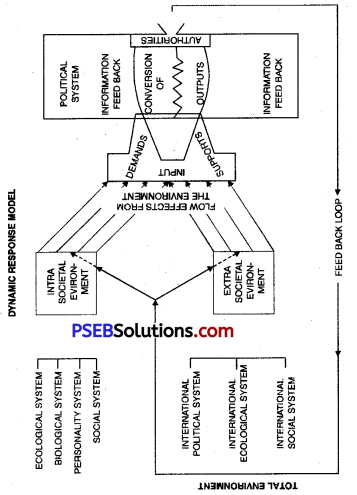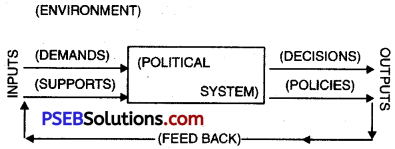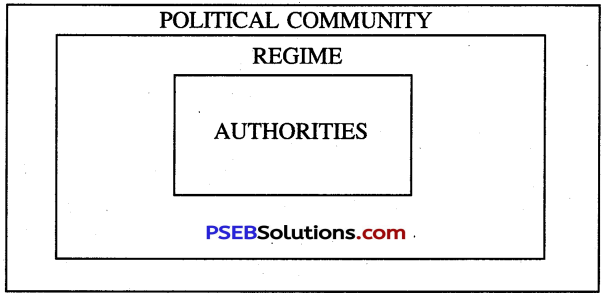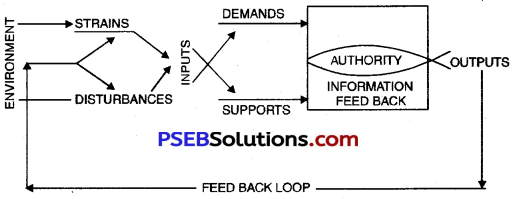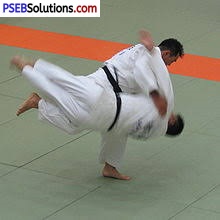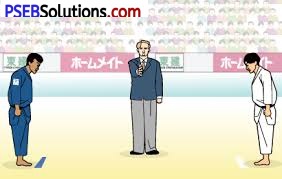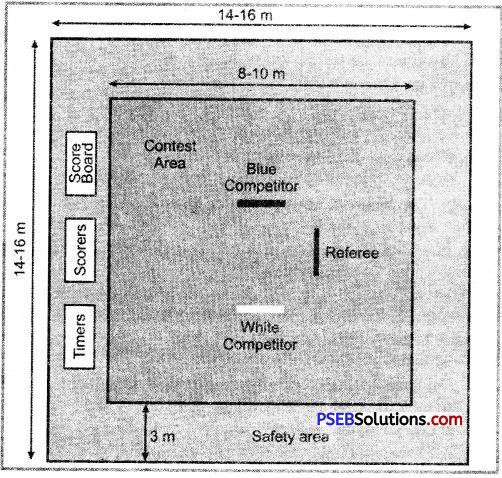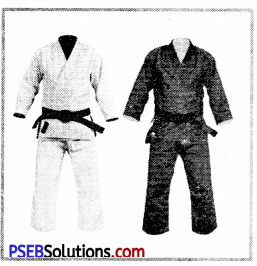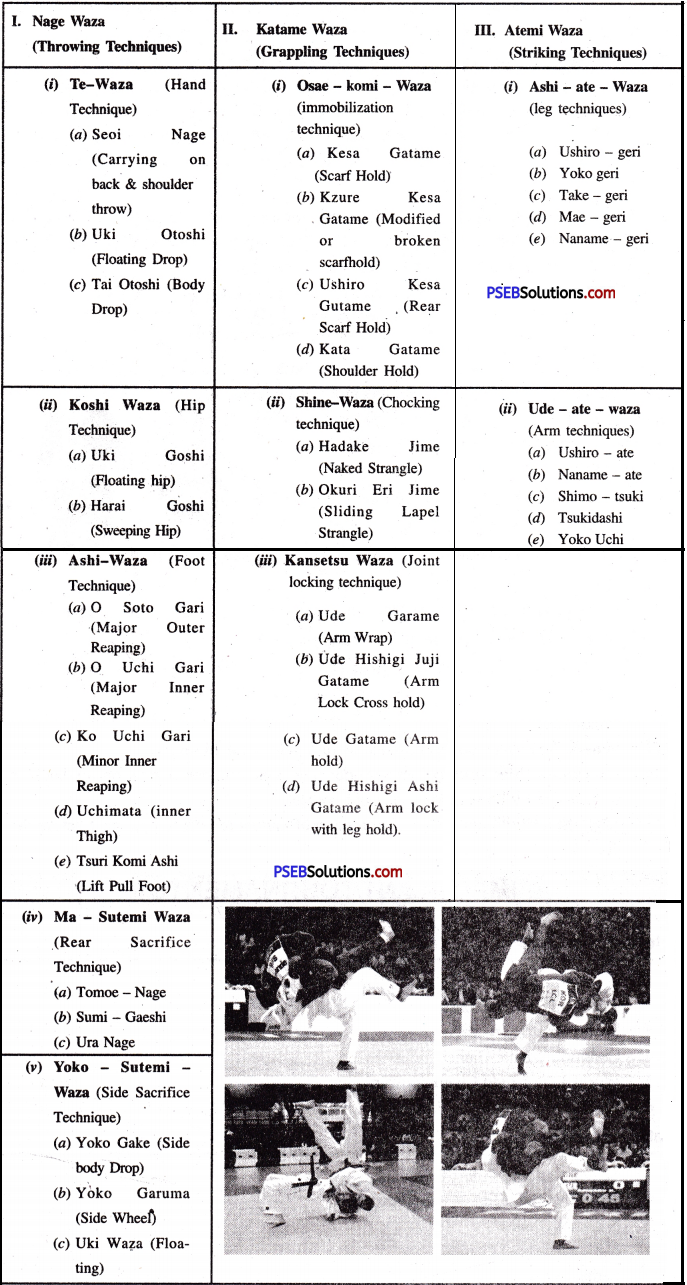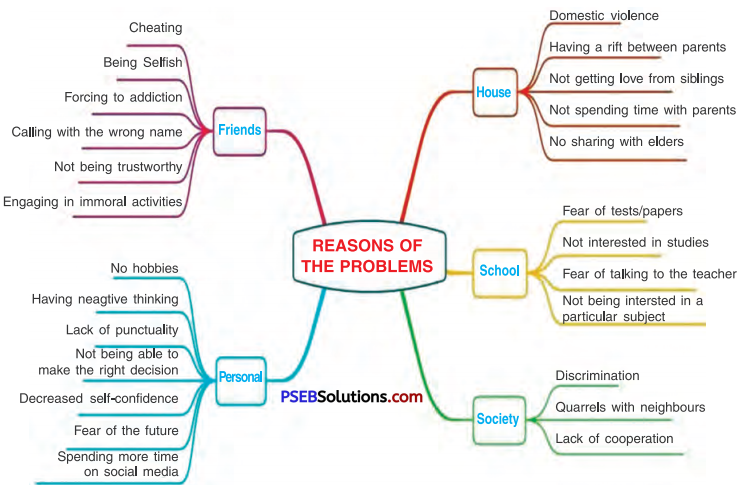Punjab State Board PSEB 12th Class Political Science Book Solutions Chapter 5 Bureaucracy (Civil Services) Textbook Exercise Questions and Answers.
PSEB Solutions for Class 12 Political Science Chapter 5 Bureaucracy (Civil Services)
Long Answer Type Questions
Question 1.
Define Bureaucracy. Write main characteristics of Bureaucracy.
Or
Define Bureaucracy. Describe main characteristics of Bureaucracy.
Or
Explain the main characteristics of Bureaucracy.
Or
Explain any six characteristics of Bureaucracy.
Answer:
Bureaucracy has been derived from French word ‘Bureau’ which means desk or writing table. Hence bureaucracy means ‘Desk Government.’ The meaning of this word has been changing with the passage of time. This word is widely misinterpreted and it is used to mean arbitrariness, wastefulness, officiousness and regimentation. In the words of John A. Weig, “Through distortion and caricature, the term bureaucracy has come to imply bungling, arbitrariness, wastefulness, officiousness and regimentation.”
In spite of the distorted meaning of bureaucracy, it has assumed importance in democracy and in a welfare state. This word is used to the maximum to prove the effect of public services. Generally in all the modern states the functions of the government are carried out by those officials who possess administrative ability and understanding of administrative problems. This body of officials is called bureaucracy. Different definitions of bureaucracy are as follows:
1. According to Willoughby, “It is to describe any personnel system of administration composed of a hierarchy of sections, divisions, bureaus and departments.” In a narrow meaning “A body of public servants organised in a hierarchical system which stands outside the sphere of effective public control.”
2. According to Marshall E. Dimock, “Bureaucracy means specialisation of hierarchies and long lines of communication.”
3. According to Max Weber, “A system of administration characterized by expertness, impartiality and the absence of humanity.”
4. According to Joshi, “Bureaucracy is a system of government where power is concentrated into the hands of civil servants.”
5. According to Gladden, “The term Bureaucracy means a regulated administrative system organised as a series of interrelated offices.”
6. According to Paul Appleby, “It is a professional class of technically skilled persons who are organised in an hierarchical way and serve the state in an impartial manner.”
Characteristics of Bureaucracy:
Important characteristics of bureaucracy are as follows:
1. Logical division of functions:
The whole administration is divided on the basis of its duties. The administration is logically divided in hierarchies and system is established.
2. Technical Specialisation:
Technical specialisation is an important feature of bureaucracy. Bureaucracy originated only because of technical specialization. An employee is trained in a particular art and gains proficiency by doing the same work repeatedly and so he becomes a specialist in his field.
3. Hierarchical Principle: All the employees are bound by ‘unity of command’ and bureaucracy is divided in hierarchies.
4. The Legal Framework:
The employees in bureaucracy work in a legal framework and so they become strict and harsh. The administrative laws, rules and decisions are in written form.
5. Political Neutrality:
In bureaucracy, an employee’s personal and political views hold no value. A bureaucrat has to remain neutral from political view point. They are neither the members of any political party nor they are connected with any of them. The Government may be of any political party, but the bureaucrats have to serve the administration according to their ability.
6. Merit System: Bureaucracy is based on merit system. The employees are selected on the basis of their ability.
7. Permanent Post: The posts of Civil Services are permanent. The employees remain in service till the age of retirement.
![]()
Question 2.
Write an essay on the recruitment of Civil Servants.
Answer:
The success and efficiency of administration depends on Civil Servants. An able administration can’t be imagined without proficient employees. But it is very difficult to have honest, capable and hardworking employees. That is why proper recruitment has become a problem in almost all the countries. Recruitment doesn’t merely mean the filling up of vacant posts, but it is a process through which able individuals are attracted towards the vacant posts. Broadly speaking, the recruitment of Civil Servants can be divided into two parts Negative and Positive.
The aim of negative recruitment is to keep clever and incapable persons away from government posts. The recruiting authority formulates such laws that only able individuals get the chance to become its candidates. The aim of positive recruitment is to attract suitable and capable persons for various Government posts.
Every Government tries its best to appoint proficient persons against administrative posts. But several questions regarding recruitment arise such as who should be authorised for recruitment ? Whether the employees should be recruited from outside or inside the office ? What should be the qualifications to fill different posts ? How should the ability of the candidates be determined ?
The administrative officials are selected on merit basis in most of the countries and their selection is completed through four methods mentioned below:
1. Individual decision of the appointing official:
This process leaves the responsibility to determine the ability of candidates on appointing authority. The candidate appears before the appointing official who gathers every information about the candidate through questions and mutual conversation. Thus a suitable candidate is recruited.
2. Testimonials of ability and character:
The ability of the candidates is sufficiently judged from their testimonials. These testimonials are related to Lheir education, character, sports, cultural activities etc.
3. Record of previous experience:
The candidates’ records of previous experience reflect their ability for the appointment against administrative posts.
4. Examinations:
The most popular method to judge the ability of candidates is examination system. There are two types of Examinations to select candidates Competitive Examination and Examination without competition. Competitive Examination has double purpose firstly, it finds out a candidate with minimum required qualification for the post and secondly to ascertain his mental condition from the angle of ability. Non-competitive examination ascertains candidate’s minimum qualification fixed for the post. It is quite obvious that competitive examination should be adopted to select best candidates.
The administrative officials in England are appointed through competitive examination. Interview is essential after the written test. Union Public Service Commission and State Service Commissions have been set up in India to recruit government officials.
![]()
Question 3.
Describe main differences between Political Executive and Permanent Executive.
Or
Write down the meaning of Political Executive and Permanent Executive and explain in detail the differences between the two.
Answer:
Executive has two parts-Political Executive and Permanent Executive. Political Executive includes President, Ministers, Parliamentary Secretary and they are elected through a definite process and for a definite period. Permanent Executive consists of civil servants, administrative officials and employees and they are retired at a fixed age. Following are the differences between Political Executive and Permanent Executive:
1. Difference between the appointments of the two:
The appointment or selection of Political Executive is in the hands of electorates. In Parliamentary form of government, the party with majority votes in the lower house of Parliament is called upon to elect its leader. The leader of the party is installed as a Prime Minister who forms his Cabinet. England and India have this system.
Permanent Executive is called Administrative Service or Civil Service. Competitive Examinations are held to test the ability of candidates. They have to get through written tests and interview. Thereafter a list of successful candidates is prepared to impart training.
Distinction between the two on Political Basis. Political Executive is completely mixed with political parties as it is elected on political basis. Political executive views all the problems from political angle.
On the contrary, civil servant doesn’t take part in politics. Government officials remain indifferent to party politics. They can neither become the members of political parties nor can they contest Parliamentary and Assembly elections.
![]()
Question 4.
Explain the verbal meaning of word ‘Bureaucracy’. Explain its role/functions from four aspects in democracy.
Or
What is the role of bureaucracy in Modern Welfare State?
Answer:
Bureaucracy has been derived from French word ‘Bureau’ which means desk or writing table. Hence bureaucracy means ‘Desk Government.’ The meaning of this word has been changing with the passage of time. This word is widely misinterpreted and it is used to mean arbitrariness, wastefulness, officiousness and regimentation. In the words of John A. Weig, “Through distortion and caricature, the term bureaucracy has come to imply bungling, arbitrariness, wastefulness, officiousness and regimentation.”
In spite of the distorted meaning of bureaucracy, it has assumed importance in democracy and in a welfare state. This word is used to the maximum to prove the effect of public services. Generally in all the modern states the functions of the government are carried out by those officials who possess administrative ability and understanding of administrative problems. This body of officials is called bureaucracy. Different definitions of bureaucracy are as follows:
1. According to Willoughby, “It is to describe any personnel system of administration composed of a hierarchy of sections, divisions, bureaus and departments.” In a narrow meaning “A body of public servants organised in a hierarchical system which stands outside the sphere of effective public control.”
2. According to Marshall E. Dimock, “Bureaucracy means specialisation of hierarchies and long lines of communication.”
3. According to Max Weber, “A system of administration characterized by expertness, impartiality and the absence of humanity.”
4. According to Joshi, “Bureaucracy is a system of government where power is concentrated into the hands of civil servants.”
5. According to Gladden, “The term Bureaucracy means a regulated administrative system organised as a series of interrelated offices.”
6. According to Paul Appleby, “It is a professional class of technically skilled persons who are organised in an hierarchical way and serve the state in an impartial manner.”
Characteristics of Bureaucracy:
Important characteristics of bureaucracy are as follows:
1. Logical division of functions:
The whole administration is divided on the basis of its duties. The administration is logically divided in hierarchies and system is established.
2. Technical Specialisation:
Technical specialisation is an important feature of bureaucracy. Bureaucracy originated only because of technical specialization. An employee is trained in a particular art and gains proficiency by doing the same work repeatedly and so he becomes a specialist in his field.
3. Hierarchical Principle: All the employees are bound by ‘unity of command’ and bureaucracy is divided in hierarchies.
4. The Legal Framework:
The employees in bureaucracy work in a legal framework and so they become strict and harsh. The administrative laws, rules and decisions are in written form.
5. Political Neutrality:
In bureaucracy, an employee’s personal and political views hold no value. A bureaucrat has to remain neutral from political view point. They are neither the members of any political party nor they are connected with any of them. The Government may be of any political party, but the bureaucrats have to serve the administration according to their ability.
6. Merit System: Bureaucracy is based on merit system. The employees are selected on the basis of their ability.
7. Permanent Post: The posts of Civil Services are permanent. The employees remain in service till the age of retirement.
Role/Functions of Bureaucracy:
The influence of bureaucracy on administration has increased a lot. It is difficult to run administration without bureaucracy. Bureaucracy has become vital because modern State is a welfare state and its functions are so vast that they can’t be handled by Ministers alone. The Ministers need civil servants to perform these functions. The role of Bureaucracy can be studied under following heads:
1. Administrative Functions or Role:
Administrative function is the key function of bureaucracy. A minister formulates a policy but the responsibility of implementing the same falls on bureaucracy. Even a good policy can prove worthless in case it is not implemented effectively.
2. To Influence the Policy:
Though policies are framed by political executive, yet bureaucracy contributes a lot to policy-formation on the basis of their ability. The Civil Servants provide statistics to Ministers at the time of framing a policy.
3. Advisory Functions or Role:
Bureaucracy plays a vital role in advising Political Executive. Since the Ministers possess no technical knowledge of their departments, they depend on the Civil Servants to run administration.
4. Legislative Functions or Role:
Bureaucracy plays an important role in making legislation. In countries like India and England having Parliamentary form of Governments, most of the bills are presented by Ministers in Parliament. The outlines of these bills are prepared by Permanent employees. The Civil Servants propose various laws to solve social, economic and political problems.
5. Financial Functions or Role:
Bureaucracy plays a significant role even in financial sphere. Parliament passes a budget every year and the budget is presented by Finance Minister in a Parliamentary system. Though Cabinet forms a policy related to budget, yet its outlines are prepared by bureaucracy. The collection of taxes, expenditure according to budget and other functions related to it are performed by bureaucracy.
6. Co-ordination:
Efficiency of an administration depends upon co-ordination among different departments. This desired co-ordination is established by Civil Servants.
7. Judicial Functions or Role:
Some important judicial functions are performed by Administrative Tribunals. It is so because of the increased number of Administrative Laws and Administrative Adjudication. Thus an administrator not only runs administration, but performs judicial functions also.
8. Public Relation Functions:
Bureaucracy establishes relations with public in various ways to make their policies successful with their co-operation.
9. Stability in Foreign Relations:
The role of bureaucracy in foreign relations is of great importance as it brings stability in foreign relations and policies. Thus bureaucracy has become all the more influential in modern Welfare State. A state has to perform many functions for Public Welfare and the success of these depends upon the efficiency of bureaucracy.
![]()
Short Answer type Questions
Question 1.
Explain the meaning of word Bureaucracy.
Or
Explain the etymological meaning of Bureaucracy.
Answer:
Bureaucracy has been derived from the French word ‘Bureau’ which means desk or writing table. Hence bureaucracy means ‘Desk Government’. This word is used in these days to prove the effect of public services. The functions of the government are carried out by those officials who possess administrative ability and understanding of administrative problems. This body of officials is called bureaucracy.
- According to Marshall E. Dimock, “Bureaucracy means specialisation of hierarchies and long lines of communication.”
- According to Max Weber, “A system of administration characterized by expertness, impartiality and the absence of inhumanity.”
- According to Joshi, “Bureaucracy is a system of government where power is concentrated into the hands of civil servants.”
Question 2.
Write four major characteristics of Bureaucracy.
Answer:
Bureaucracy has the following characteristics:
- Fixed tenure: The posts of civil servants are permanent. The employees remain in office till the age of retirement. The change in government does not affect the tenure of civil servants.
- Political Neutrality: In bureaucracy, an employee’s personal and political view holds no value. The bureaucrats have to remain neutral from political viewpoint.
- Merit System: Bureaucracy is based on merit system. The employees are selected on the basis of their ability.
- Permanent Posts: The posts of civil services are permanent.
Question 3.
Mention four defects of Bureaucracy.
Answer:
The three main defects of bureaucracy are:
1. Red Tapism:
Bureaucracy indulges in red tapism. It causes delay in decision making by adopting a rigid attitude toward the application of all rules and regulations according to which the decisions have to be taken.
2. Unresponsive to People’s Demands: Bureaucracy ignores the needs and demands of the people.
3. Conservatism:
Bureaucracy has been a source of conservatism. Bureaucracy believes in traditional ways of administration and it mostly favours status quo in administration. Bureaucracy opposes progressive policies.
4. Bureaucracy is considered as an elite class in the society.
![]()
Question 4.
What do you understand by Recruitment?
Answer:
For a layman recruitment is something like picking up persons for filling up jobs lying vacant in some office. Technically speaking, recruitment is not only making appointments but selecting proper and suitable candidates for particular jobs. According to L.D. White, “Recruitment means specific steps taken to attract suitable candidates to apply for examination.”
Question 5.
Write down the three methods of Recruitment.
Answer:
There are two methods of recruitment:
1. Recruitment from within:
Recruitment from within means that recruitment to high post should be made from within the department or from those employees who are already in service. In this method employees get higher post by promotion.
2. Recruitment from without:
Recruitment from without means that recruitment should be made openly. In this method recruitment is done on the basis of merit and any person who is eligible for the post can apply for recruitment. This method is also known as direct method of recruitment.
3. Mixed Method:
These two methods are not mutually exclusive and all governments use both these methods. However, direct recruitment should be the rule at lower level and recruitment to class 1 should be made through competitive examination.
![]()
Question 6.
Write four differences between Political Executive and Permanent Executive.
Or
Distinguish between Political and Permanent Executive.
Answer:
Following are the main differences between Political Executive and Permanent Executive:
1. Difference between the appointments of the two:
In the democratic countries the political executive is elected directly or indirectly on the basis of adult franchise. On the other hand, permanent executive or civil servants are appointed on the basis of merit. Competitive examinations are held to test the ability of candidates.
2. Distinction between the two on Political Basis:
Political Executive is completely mixed with political parties as it is elected on political basis. Political executive views all the problems from political angle.
On the contrary, civil servants don’t take part in politics. Government officials remain indifferent to party politics. They can neither become the members of political parties nor can they contest Parliamentary and Assembly elections.
3. Difference on the basis of Term:
Political executive undergoes a change according to the change in politics. On the other hand, civil servants remain in office till a definite age. Administrative services are not affected by change in political executive. Civil servants retire at a fixed age.
4. Political executive owes responsibility to parliament and people for all its actions whereas it is not so in the case of permanent executive.
Question 7.
Write down four merits of good Bureaucracy.
Answer:
A good bureaucracy has the following qualities:
1. Ability: The civil servants should be able and experienced.
2. Public Interest:
The civil servants should take care of public interest. They should always attach more importance to national interest than personal interest.
3. Impartial:
The most important trait of a good civil service is that it should be impartial. It should not be connected with a particular party. It should remain aloof from all political activities.
4. Bureaucrats should be honest and selfless.
![]()
Question 8.
Bureaucracy is known as ‘the backbone of Administration’. Why?
Or
What is the importance of Bureaucracy in Democracy?
Answer:
The importance of civil services is increasing day by day in modern democratic states. Bureaucracy or civil servants are the eyes, ears, hands and brains of public administration. It has rightly been remarked as the backbone of the administration. We can prove this with the help of following logics:
- The civil servants provide continuity to public administration.
- The role of civil servants in foreign relations is of great importance as it brings stability in foreign relations and policies.
- The civil servants act as a link between the government and the people.
- The civil servants provide expert knowledge to ministers.
Question 9.
What is the meaning of permanent executive?
Answer:
Executive has two parts political executive and permanent executive. The part of the executive which holds office on the basis of its education or qualifications is called the permanent executive. Permanent executive consists of civil servants, administrative officials and employees and they are selected on the basis of merit system. The civil servants retire at a fixed age and they work under the supervision and direction of political executive.
Question 10.
Mention any four functions of Political Executive.
Or
Explain the role of Political Executive in a democratic state.
Answer:
Following are the main functions of political executive in a democratic state:
1. Administrative Function:
The main function of the political executive is , maintenance of law and order. The political executive enforces the laws enacted by the legislature and maintains peace in the state. The executive is to see that all the laws are properly obeyed and respected and those who break the laws are punished.
2. Formulation of Policies:
Formulation of policies is an important function of the political executive. Executive decides the internal and external policies of the nation and runs the administration on the basis of that policy.
3. Powers of Appointment and Removal:
Political executive makes many appointments. In India, Judges of the Supreme Court, High Courts, Ambassadors, Advocate General, Members of the Union Public Service Commission, Members of the Finance Commission etc. are appointed by the President. Political executive also enjoys the power to remove top officials of the administration.
4. Functions Regarding Foreign Relations:
Political executive determines the foreign policy of the country. Political executive also decides the relations with other countries. For this purpose political executive makes various international agreements and treaties.
![]()
Question 11.
Write four functions of good Bureaucracy.
Or
Write any four functions of Bureaucracy.
Answer:
Without bureaucracy it is not possible to run the administration. The main functions of bureaucracy are as given below:
1. Administrative Function or Role:
Administrative function is the key function of bureaucracy. A minister formulates a policy but the responsibility of implementing the same falls on bureaucracy. Even a good policy can prove worthless in case it is not implemented effectively.
2. To Influence the Policy:
Though policies are framed by political executive, yet bureaucracy contributes a lot to policy formation on the basis of their ability. The civil servants provide statistics to Ministers at the time of framing policy.
3. Advisory Functions or Role:
Bureaucracy plays a vital role in advising political executive. Since the Ministers possess no technical knowledge of their departments, they depend upon the civil servants to run the administration.
4. The civil servents propose various laws to solve social, economic and political problems.
Question 12.
Explain the spoil system as a method of recruitment of Bureaucracy.
Answer:
The spoil system as a method of recruitment has been in practice for a long time in U.S.A. and some other countries some time ago. By this system recruitment of civil servants goes on political basis. After general elections, the government which comes into existence starts recruiting those persons who helped at the time of elections. The supporters of defeated party immediately resign from their posts. The newly formed government appoints her supporters on those posts. In this method the tenure of the civil servants goes with the term of the government. This method of recruitment is very defective because the base of recruitment is political and not the ability.
![]()
Question 13.
What do you mean by Political Executive? Enumerate its four functions.
Or
What do you mean by Political Executive?
Answer:
Political executive includes President, Ministers and Parliamentary Secretaries. They are elected through a definite process and for a definite period. Political executive is elected purely on political basis. Political executive is responsible for all its actions to the Parliament and the people.
Functions of Political Executive.
Following are the main functions of political executive in a democratic state:
1. Administrative Function:
The main function of the political executive is , maintenance of law and order. The political executive enforces the laws enacted by the legislature and maintains peace in the state. The executive is to see that all the laws are properly obeyed and respected and those who break the laws are punished.
2. Formulation of Policies:
Formulation of policies is an important function of the political executive. Executive decides the internal and external policies of the nation and runs the administration on the basis of that policy.
3. Powers of Appointment and Removal:
Political executive makes many appointments. In India, Judges of the Supreme Court, High Courts, Ambassadors, Advocate General, Members of the Union Public Service Commission, Members of the Finance Commission etc. are appointed by the President. Political executive also enjoys the power to remove top officials of the administration.
4. Functions Regarding Foreign Relations:
Political executive determines the foreign policy of the country. Political executive also decides the relations with other countries. For this purpose political executive makes various international agreements and treaties.
Question 14.
What is the meaning of Hierarchical organisation of Bureaucracy?
Answer:
Hierarchy means the control of higher authority over his subordinates. When many people work in an organisation it is necessary it stipulates who will issue instructions and to whom. As a result of this process, the organisation is divided into many levels. Every level is responsible to its higher level and acts upon the instruction of its higher level. According to White, “To fix the relation between the highest to lowest employee; is essential in an organisation. According to Pfiffner, “By Hierarchy principle we mean the connection of Authority and Power with their immediate superiors and juniors in such a way that the Head is small and base is expanded.”
![]()
Question 15.
Write down four characteristics of Political Executive.
Answer:
Following are the main characteristics of Political Executive:
1. Appointment by the Electorate:
The appointment or selection of political executive is in the hands of electorate. In parliamentary form of government, the party with majority votes in the lower house of Parliament is called upon to elect its leader. The leader of the party is installed as the Prime Minister who forms his Cabinet.
2. Appointment on Political Basis:
Political executive is completely mixed with political parties as it is elected on political basis. Political executive views all the problems from political angle.
Very Short Answer type Questions
Question 1.
Discuss the meaning of word Bureaucracy.
Answer:
Bureaucracy has been derived from the French word ‘Bureau’ which means desk or writing table. Hence bureaucracy means ‘Desk Government’. The functions of the government are carried out by those officials who possess administrative ability and understanding of administrative problems. This body of officials is called bureaucracy.
Question 2.
Mention any two definitions of Bureaucracy.
Answer:
1. According to Marshall E. Dimock, “Bureaucracy means specialisation of hierarchies and long lines of communication.”
2. According to Max Weber, “A system of administration characterized by expertness, impartiality and the absence of inhumanity.”
Question 3.
Mention any two major characteristics of Bureaucracy.
Answer:
Bureaucracy has the following characteristics:
1. Fixed tenure:
The posts of civil servants are permanent. The employees remain in office till the age of retirement. The change in government does not affect the tenure of civil servants.
2. Political Neutrality:
In bureaucracy, an employee’s personal and political view holds no value. The bureaucrats have to remain neutral from political viewpoint.
![]()
Question 4.
Mention two defects of Bureaucracy.
Answer:
Following are the three main defects of bureaucracy:
1. Red Tapism. Bureaucracy indulges in red tapism:
It causes delay in decision making by adopting a rigid attitude toward the application of all rules and regulations according to which the decisions have to be taken.
2. Unresponsive to People’s Demands: Bureaucracy ignores the needs and demands of the people.
Question 5.
What do you understand by Recruitment?
Answer:
For a layman recruitment is something like picking up persons for filling up jobs lying vacant in some office. Technically speaking, recruitment is not only making appointments but selecting proper and suitable candidates for particular jobs.
Question 6.
Distinguish between Political and Permanent Executive.
Answer:
1. Difference between the appointments of the two. In the democratic countries the political executive is elected directly or indirectly on the basis of adult franchise. On the other hand, permanent executive or civil servants are appointed on the basis of merit.
2. Distinction between the two on Political Basis. Political Executive is completely mixed with political parties as it is elected on political basis.On the contrary, civil servants don’t take part in politics.
![]()
Question 7.
Mention any two merits of good Bureaucracy.
Answer:
A good bureaucracy has the following qualities:
- Ability: The civil servants should be able and experienced.
- Public Interest: The civil servants should take care of public interest. They should always attach more importance to national interest than personal interest.
Question 8.
What is the importance of Bureaucracy in Democracy?
Answer:
- The civil servants provide continuity to public administration.
- The role of civil servants in foreign relations is of great importance as it brings stability in foreign relations and policies.
Question 9.
What is the meaning of permanent executive?
Answer:
Executive has two parts-political executive and permanent executive. The part of the executive which holds office on the basis of its education or qualifications is called the permanent executive. Permanent executive consists of civil servants, administrative officials and employees and they are selected on the basis of merit system.
Question 10.
Write down any two functions of Political Executive.
Answer:
1. Administrative Function:
The main function of the political executive is maintenance of law and order. The political executive enforces the laws enacted by the legislature and maintains peace in the state. The executive is to see that all the laws are properly obeyed and respected and those who break the laws are punished.
2. Formulation of Policies:
Formulation of policies is an important function of the political executive. Executive decides the internal and external policies of the nation and runs the administration on the basis of that policy.
![]()
Question 11.
Write any two functions of Bureaucracy.
Answer:
1. Administrative Function or Role:
Administrative function is the key function of bureaucracy. A minister formulates a policy but the responsibility of implementing the same falls on bureaucracy. Even a good policy can prove worthless in case it is not implemented effectively.
2. To Influence the Policy:
Though policies are framed by political executive, yet bureaucracy contributes a lot to policy formation on the basis of their ability.
Question 12.
What do you mean by Political Executive?
Answer:
Political executive includes President, Ministers and Parliamentary Secretaries. They are elected through a definite process and for a definite period. Political executive is elected purely on political basis. Political executive is responsible for all its actions to the Parliament and the people.
Question 13.
Write down two merits of Direct recruitment of Bureaucracy.
Answer:
- Democratic: It upholds the democratic principle.
- Wider field: It provides wider field of recruitment.
![]()
One Line Answer Type Questions
Question 1.
From which language the word “Bureaucracy” has been derived?
Answer:
Latin Language.
Question 2.
Explain the meaning of Bureaucracy.
Answer:
Bureaucracy is that form of administration wherein the tasks of administration are performed by those civil and administrative officials who sit in chair and work on the table.
Question 3.
Who developed the Concept of Bureaucracy?
Answer:
Max Weber developed the concept of bureaucracy.
Question 4.
Write any one definition of bureaucracy.
Answer:
According to Paul H. Appleby, “Bureaucracy is a professional class of technically skilled persons who are organised in an hierarchical way and serve the state in an impartial manner.”
Question 5.
Mention any one characteristic of bureaucracy.
Answer:
Bureaucracy is organised on hierarchical basis.
![]()
Question 6.
Mention any one function of bureaucracy.
Answer:
To cooperate with the ministers.
Question 7.
Explain the meaning of Political Executive.
Answer:
Political Executive is directly or indirectly elected by the people. No specific educational or technical qualification is fixed for the Political Executive.
Question 8.
“Civil Service is a professional body of officials permanent, hard and skilled.” Who said it?
Answer:
Finer.
Question 9.
Which mode of recruitment is regarded as ‘Spoil System’ for Bureaucracy?
Answer:
Recruitment based on Politics is regarded as ‘Spoil System’ for Bureaucracy.
Question 10.
Write the meaning of Permanent Executive.
Answer:
Permanent Executive is another name for administrative services or administrative officials.
Question 11.
Mention any one difference between Political Executive and Permanent Executive.
Answer:
The base of Political Executive is political whereas political impartiality is the main characteristic of Permanent Executive.
Question 12.
Write any one attribute of good bureaucracy.
Answer:
It should be appointed on the basis of merit.
![]()
Question 13.
Write any one merit of direct recruitment of Bureaucracy.
Answer:
It is based on Democratic method.
Fill in The Blanks
1. The word ‘Bureaucracy’ has been derived from ………………………. language.
Answer:
Latin
2. ………………………. developed the concept of bureaucracy.
Answer:
Max Weber
3. In ………………………. the principle of merit was adopted in England.
Answer:
1857
4. In India in ………………………. merit was made the basis of recruitment.
Answer:
1853
5. Bureaucracy is organised on ………………………. basis.
Answer:
hierarchical.
![]()
True Or False Statement
1. Bureaucracy has been derived from Greek language.
Answer:
False
2. David Easton developed the concept of bureaucracy.
Answer:
False
3. Bureaucracy is organised on hierachical basis.
Answer:
True.
4. Permanent executive is another name for administrative services.
Answer:
True.
5. In India in 1909 merit was made the basis of recruitment.
Answer:
False
6. Political executive is directly or indirectly elected by the people.
Answer:
True.
![]()
Choose The Correct Answer
Question 1.
The word ‘Bureaucracy’ is derived from which language?
(a) English
(b) Latin
(c) French
(d) Greek.
Answer:
(c) French
Question 2.
In French language, what is the meaning of word ‘Bureau’?
(a) Government
(b) Political Parties
(c) State
(d) Desk.
Answer:
(d) Desk.
![]()
Question 3.
To whom Bureaucracy gives advice?
(a) Parliament
(b) Political Parties
(c) Ministers
(d) Judiciary.
Answer:
(c) Ministers
Question 4.
Who acts as a link between Public and Government?
(a) Parliament
(5) Religious leaders
(c) Judiciary
(d) Government Officials.
Answer:
(d) Government Officials.
![]()
Question 5.
In which of the following countries is committed Bureaucracy?
(a) England
(b) Switzerland
(c) China
(d) U.S.A.
Answer:
(c) China

